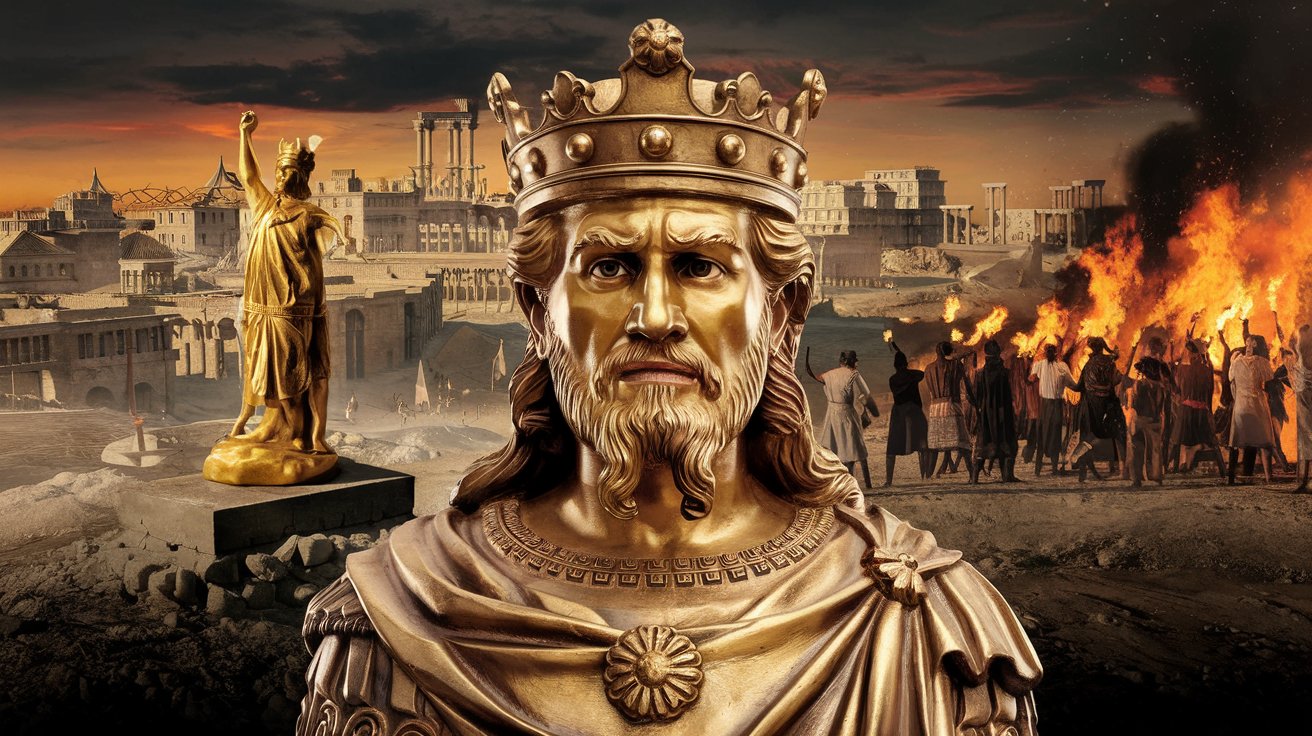
Why did Babylon revolt? The revolt of Babylon in 539 BCE was a dramatic turning point in ancient history. The Neo-Babylonian Empire, once a powerful force under Nebuchadnezzar II, faced internal strife and external threats. Nabonidus, the last king, alienated his people by suppressing the worship of Marduk, Babylon's chief deity, in favor of the moon-god Sin. This religious shift, coupled with military discontent and poor leadership from his son Belshazzar, weakened the empire. Meanwhile, Cyrus the Great of Persia seized the opportunity, leading a strategic invasion that culminated in Babylon's sudden fall. This event reshaped the region's political and cultural landscape, marking the rise of the Achaemenid Empire.
Key Takeaways:
- The Revolt of Babylon marked the end of the Neo-Babylonian Empire and the rise of the Achaemenid Empire under Cyrus the Great, shaping the course of ancient history.
- The fall of Babylon had profound cultural, religious, and military implications, paving the way for the rise of the Persian Empire and leaving a lasting legacy in Mesopotamian civilization.
The Rise and Fall of Babylon
The Revolt of Babylon is a fascinating chapter in ancient history. It marked the end of the Neo-Babylonian Empire and the rise of the Achaemenid Empire under Cyrus the Great. Here are 35 key facts about this significant event.
-
The Neo-Babylonian Empire was founded by Nabopolassar in 626 BCE. He was an Assyrian official who rebelled against the Assyrian Empire and established himself as king in Babylonia.
-
Nebuchadnezzar II, Nabopolassar's son, expanded the empire significantly. He conquered Judah and incorporated Phoenicia and Cilicia into the empire.
Nabonidus and His Reign
Nabonidus, the sixth ruler of the 11th Dynasty, brought significant changes during his reign. His actions and decisions played a crucial role in the events leading to the fall of Babylon.
-
Nabonidus suppressed the cult of Marduk, the tutelary deity of Babylon. He elevated the cult of the moon-god Sin, which alienated the local priesthoods and the population.
-
The military under Nabonidus was disenchanted with his scholarly tastes. He left the defense of the kingdom to Belshazzar, a capable soldier but poor diplomat who alienated the political elite.
Cyrus the Great and the Achaemenid Empire
Cyrus the Great, a pivotal figure in ancient history, led the Achaemenid Empire to victory over Babylon. His strategies and leadership were instrumental in this conquest.
-
Cyrus the Great, the Achaemenid Persian king of Anshan in Elam, revolted against his suzerain Astyages. This revolt took place at Ecbatana in 550/549 BCE.
-
Cyrus established his rule at Ecbatana, ending the Median Empire. This elevated the Persians among the Iranic peoples.
Persian Invasion of Babylon
The invasion of Babylon by Cyrus and his forces was a well-planned and executed campaign. It led to the sudden and unexpected fall of the city.
-
In 540 BCE, Cyrus invaded Syria, capturing many of Nabonidus’s vassals. Nabonidus had to return to Babylon in 543 BCE due to Cyrus's constant raids on the border.
-
Babylon was captured on 16th Tašrîtu, the night before the akitu festival in honor of Sin. This event marked the fall of the city.
The Fall of Babylon
The fall of Babylon was a significant event with far-reaching consequences. It marked the end of an era and the beginning of a new one under Persian rule.
-
The fall of Babylon was sudden and unexpected. A receipt for reconstruction work on the Enlil Gate demonstrates that there was a forced entry into Babylon.
-
General Ugbaru led a portion of the Persian army that penetrated the Enlil Gate. They crossed the river to take the eastern districts of Babylon.
Cultural and Religious Impact
The fall of Babylon had profound cultural and religious implications. It marked a shift in power dynamics and influenced the region's religious landscape.
-
Babylon was believed by Mesopotamians to be founded by the god Marduk. It was home to the famed Hanging Gardens, one of the Seven Wonders of the Ancient World.
-
The Cyrus Cylinder portrays Nabonidus negatively and presents Cyrus as the liberator of Babylon. Modern scholarship recognizes it as a manipulated text designed to legitimize Cyrus' conquest.
Archaeological Evidence
Archaeological findings provide valuable insights into the events surrounding the fall of Babylon. They help corroborate historical accounts and offer a glimpse into the past.
-
The Nabonidus Chronicle is a rework of history from the Persian court. It purports to be a text from Nabonidus but is especially flattering of Cyrus.
-
Archaeological evidence supports the forced entry into Babylon through the Enlil Gate. The receipt for reconstruction work on this gate indicates a significant breach in the city's defenses.
Babylonian Culture and Legacy
Babylon's rich cultural heritage and its legacy continue to captivate historians and archaeologists. The city's ruins offer a testament to its historical significance.
-
Babylon was an important center of early mathematics and astronomy. It had a lasting influence on contemporary units of measurement.
-
Hammurabi's code of laws is considered one of the most important surviving legal texts from the Ancient Near East. It was the first written collection of Mesopotamian laws to be discovered by archaeologists.
Notable Monuments and Sites
Babylon was home to several notable monuments and archaeological sites. These structures reflect the city's grandeur and historical importance.
-
Among the most famous works of Mesopotamian architecture is Babylon’s Gate of Ishtar. The monumental brick structure controlled access to the center of the city.
-
Babylon was inscribed on UNESCO’s World Heritage List in 2019. The inscription followed a nomination proposal submitted by Iraq’s State Board of Antiquities and Heritage.
The Future of Babylon
Efforts to preserve and protect Babylon's heritage continue to this day. Various projects aim to conserve the city's ruins and promote sustainable tourism.
-
The WMF launched the Future of Babylon project in 2004. This project focused on brick-and-mortar conservation work and building local heritage capacity.
-
The 2,600-year-old Lion of Babylon statue is among the most celebrated archaeological artifacts in Iraq. It has become a popular icon, gracing everything from Iraqi currency to local restaurant signage.
Historical Reassessments
Modern scholarship continues to reassess historical narratives about the fall of Babylon. These reassessments provide a more nuanced understanding of the events and their implications.
-
Gauthier Tolini has proposed a plausible reconstruction of how Babylon fell. His theory is supported by archaeological evidence and contemporary accounts.
-
The fall of Babylon had a profound cultural impact. It marked the end of an era for Mesopotamian civilization and paved the way for the rise of the Persian Empire.
Military Strategy and Leadership
The military strategies employed by Cyrus and his generals were crucial to their success. Their tactics and leadership played a significant role in the conquest of Babylon.
-
The military strategy employed by Cyrus and his generals was crucial to the success of the campaign. The diversion of the Euphrates River allowed the Persian army to enter the city undetected.
-
Cyrus the Great is often portrayed as a great warrior and leader. The Cyrus Cylinder acknowledges his triumphs and the submission of other kings to his rule.
Religious Significance
The fall of Babylon had significant religious implications. It marked a shift in religious power dynamics in the region and influenced the beliefs of the people.
-
The Babylonian gods, particularly Marduk, were seen as having been defeated by the Persian gods. This event marked a shift in religious power dynamics in the region.
-
The writing on the wall in Daniel 5 foretold the fall of Babylon. This event underscores the religious and political tensions within the empire during its final days.
Legacy of Babylon
The legacy of Babylon extends beyond ancient history. The city's ruins continue to inspire awe and curiosity, serving as a testament to the enduring legacy of Mesopotamian civilization.
-
Babylon's legacy continues to captivate historians and archaeologists. The city's ruins offer a rich tapestry of historical narratives that shape our understanding of the ancient world.
-
The fall of Babylon serves as a reminder of the complexities of political power, cultural identity, and religious influence. It highlights the intricate dynamics that shaped the course of human civilization.
-
Babylon's ruins continue to inspire awe and curiosity. They serve as a testament to the enduring legacy of Mesopotamian civilization.
-
The city's rich cultural heritage and its legacy continue to captivate historians and archaeologists. The ruins offer a glimpse into the past and the historical significance of Babylon.
-
Babylon's influence on contemporary units of measurement is a testament to its importance in early mathematics and astronomy. The city's contributions to these fields had a lasting impact.
-
The Cyrus Cylinder is recognized as a manipulated text designed to legitimize Cyrus' conquest. Modern scholarship provides a more nuanced understanding of its historical context.
-
The Nabonidus Chronicle portrays Cyrus in a flattering light. It is a rework of history from the Persian court, purporting to be a text from Nabonidus.
-
The fall of Babylon marked the end of an era for Mesopotamian civilization. It paved the way for the rise of the Persian Empire under Cyrus the Great.
-
The legacy of Babylon continues to shape our understanding of the ancient world. The city's ruins offer valuable insights into the dynamics of ancient politics, culture, and religion.
The Legacy of Babylon's Revolt
The revolt of Babylon in 539 BCE wasn't just a military defeat; it was a turning point in ancient history. The Neo-Babylonian Empire, once a beacon of culture and power, fell to Cyrus the Great's Achaemenid Empire. This event reshaped the political and cultural landscape of the Old World. The fall highlighted the internal strife under Nabonidus, the strategic brilliance of Cyrus, and the religious and social dynamics at play. Babylon's rich heritage, from Hammurabi's Code to the Ishtar Gate, continues to captivate historians and archaeologists. The city's ruins, now a UNESCO World Heritage site, remind us of its grandeur and influence. Understanding Babylon's revolt offers valuable insights into ancient politics, culture, and religion, shaping our view of human civilization's evolution.
Frequently Asked Questions
Was this page helpful?
Our commitment to delivering trustworthy and engaging content is at the heart of what we do. Each fact on our site is contributed by real users like you, bringing a wealth of diverse insights and information. To ensure the highest standards of accuracy and reliability, our dedicated editors meticulously review each submission. This process guarantees that the facts we share are not only fascinating but also credible. Trust in our commitment to quality and authenticity as you explore and learn with us.


